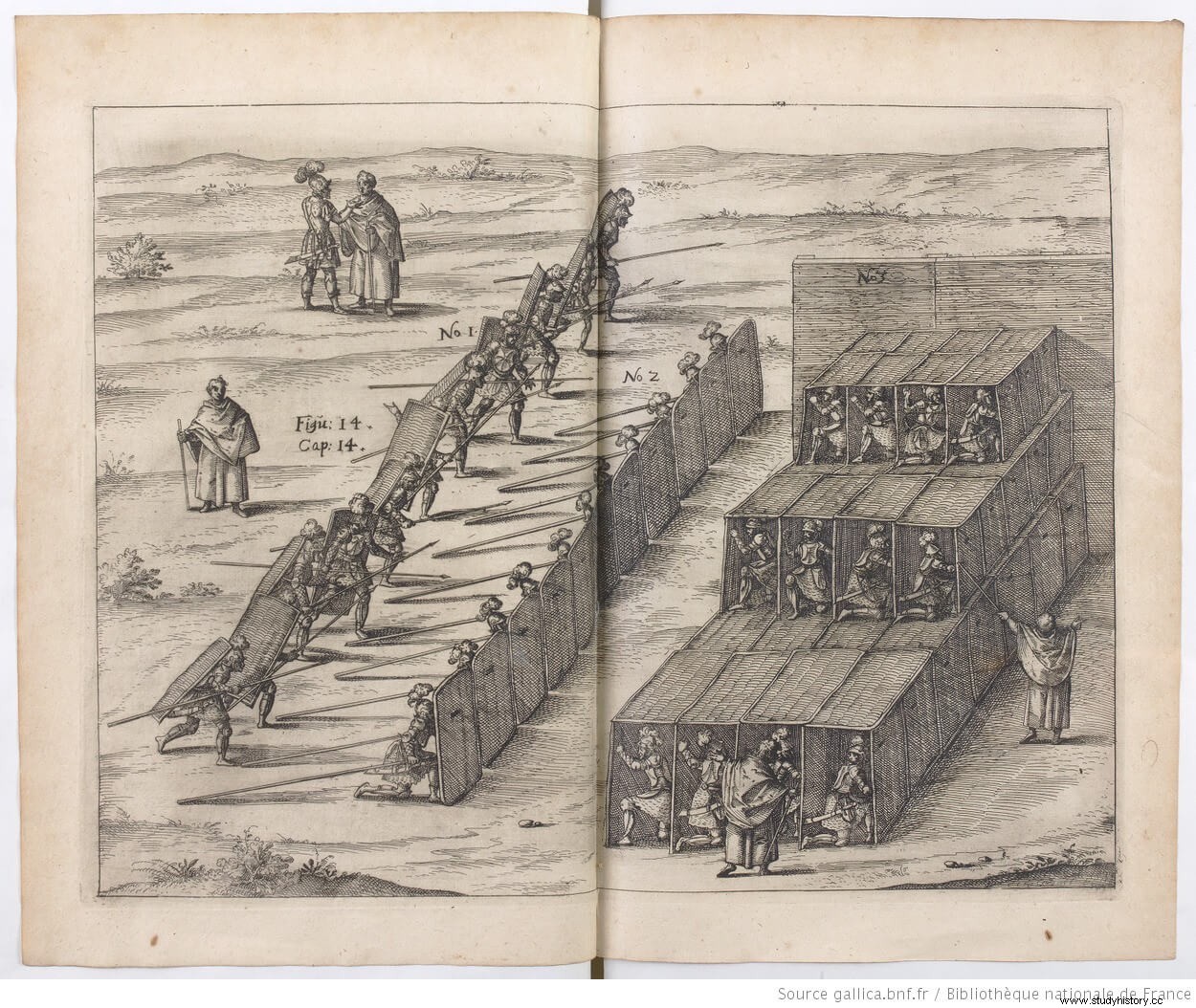
Chance, and my experience in Roman military recreation , made César Solar, manager of the All 4 Action company, offer me in August 2015 to work as a historical consultant for the filming of a skirmish between legionnaires and a group of Jewish rebels. Although I didn't know it then, it was the opening sequence of the movie Risen by Kevin Reynolds , known in Spain as Resucitado . A contingent of 130 Roman legionnaires had to take an assault on a wall almost two meters high defended by zealots and Solar was still not sure how to solve this scene that was going to be shot in the Almeria desert of Tabernas. At that point it occurred to me that the best solution might be a testudo ramp. .
The testudo
The testudo , the famous Roman “tortoise” , it was a very compact formation in which the legionnaires created a roof with the shields covered by the front and, sometimes, the sides. According to textual sources, the top of this "box" could sometimes tilt to form a ramp from which other soldiers stormed a wall. The idea convinced the coordinator of the action scenes, so I made an illustrated dossier and, later, a storyboard that was not so much a visual guide to the shots as a way of showing the different phases of the maneuver. The testudo ramp pleased the director, since it combined visual spectacularity with verisimilitude, while allowing him to film something hitherto unseen in cinema. My career in Hollywood was about to begin and, to tell the truth, I didn't have it all with me. Although he had experience in training a small number of re-enactors in maneuvers that included the testudo, it is not a simple operation, a large number of people had to be trained in a very short time, and above all he did not know if the testudo ramp it was really functional.
The testudo used for defensive purposes and is usually mentioned in two contexts:to protect soldiers from enemy projectiles or to approach a wall during a siege. Cassius Dio mentions the use of the testudo in the marches of the campaign part of Marco Antonio towards 36 a. C. The baggage, the horsemen and the personnel without a shield were placed in the center of the column, while the legionnaires and the auxilia they formed the “turtle” on the outside and protected the rest. Despite the cinematic image of legionnaires charging into testudo , as in The Eagle Legion by Kevin MacDonald, he knew that such a dense formation forces soldiers to crowd too closely together to fight, and of course prevents them from running.
The space between legionnaires it was of vital importance in the Roman way of fighting, as was made clear at Cannae after Hannibal's pincer movement. According to Polybius, the ideal space occupied by a legionnaire in a battle formation was a square of six Roman feet (1.8 x 1.8 m). In his military treatise, Vegetius considers that each legionary should cover a front of three feet (0.9 m) and that, between each row, there should be a distance of seven (2.1 m). This space would be necessary both to throw the pilum like to fight with the sword. In other words, if you want to fight, the testudo it has to break.
To cover the sides of the testudo , a column of legionnaires must be "interspersed" on each side (see figure), which makes a hasty march difficult, let alone a charge. The evolution from the testudo to an open formation −or vice versa− not only requires time, but also implies an enormous variation in the density of the square and, therefore, in the surface and the battlefront that it occupies. All this has infinite practical implications, given that any deployment from the testudo an open formation must begin in the columns at the ends of the painting, to be added, progressively, those of the interior. In short, the scenes in which a legion forms in testudo against a volley of projectiles shortly before melee, as in Gladiator by Ridley Scott, are falsified in the montage.
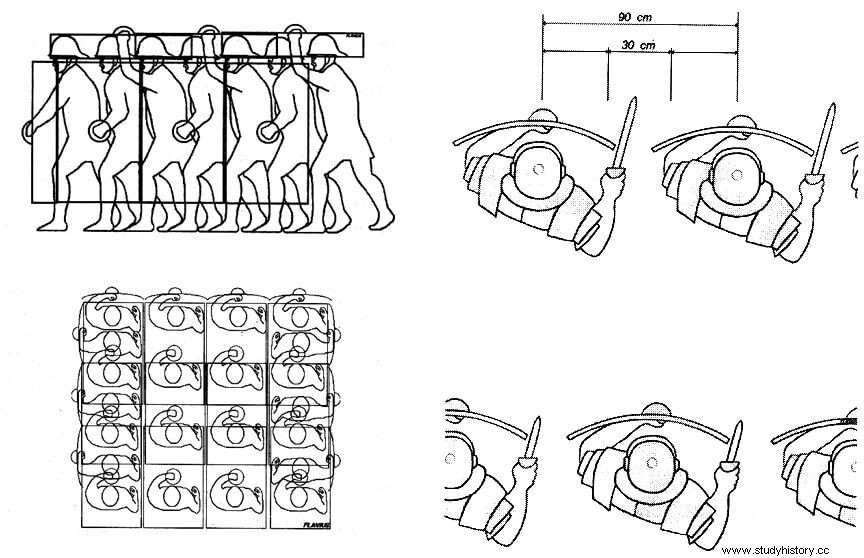
The testudo it was an improvised substitute for siege engines such as the vinea , a wooden structure covered with skins that allowed the besiegers to approach the walls safe from projectiles. A resource that was not only common in the Roman army, since Julius Caesar mentions it among the Gauls (BG II.6):
The ramp of testudo it meant going a step further, in case there were no means to scale the defenses. The most detailed description of this maneuver comes from Tito Livio (44.9.6-10) when he narrates the capture of Heraklion (169 BC) during the Third Macedonian War:
Livy tells us that this ramp had been made by young Romans who "adapted circus games to the needs of war". The Paduan historian wrote Ab urbe condita a century and a half after the events and, in military matters, he is considered an unreliable source. Cornelius Tacitus (Stories IV.23) mentions the testudo ramp again when he narrates how an army of Batavians and other Germanic peoples tries to take a Roman camp. During the assault, the barbarians form a ramp with their shields and use rudimentary siege engines, “something unusual for them”, following the instructions of Roman deserters and prisoners. In the end such innovations were unsuccessful, as the attack was thwarted by Roman artillery.
Although Dio Cassius (49.39.3) claims that the roof created by the overlapping shields in testudo it was solid enough for a car to drive over, when making my storyboard he was unaware of the credit he should give to these passages. The only visual reconstructions he knew of were Renaissance and Baroque engravings, showing legionnaires forming “ turtles” of several levels to conquer fortifications even ten meters high.

From theory to practice
As an illustrator I was −and still am− aware that “the paper holds everything” . Illustrations can be a great help in any recreation, but when you try to translate that image into the real world, unexpected problems always arise.
Once in Almería, the capital of the spaghetti western , our most immediate challenge was to make 130 people, mostly young people with no military training, look like an army. From a tactical point of view, the basic unit of the high imperial Roman army was the century, theoretically composed of 80 legionnaires. Two centuries formed a maniple in which the first unit fought ahead of the second, and three maniples constituted a cohort of 480 men. Given that we only had 130 individuals, including extras and specialists, I wanted to recreate the operation of a manipule with two diminished centuries. My proposal for the assault on the wall defended by zealots was, ultimately, the following:
- The two centuries advance towards the wall, one after the other.
- Before coming into missile range, the second century traverses the first through the corridors created between the columns, and as they exit the battlefront, the unit forms in testudo .
- The testudo Move to the foot of the wall and create a ramp.
- The first century climbs up the ramp to the top of the wall.
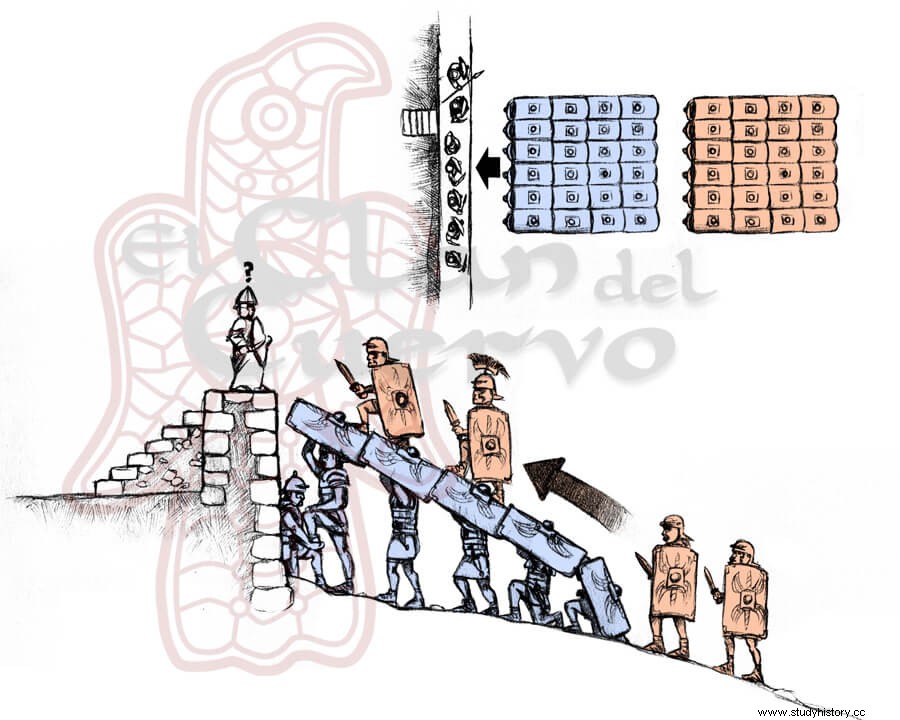
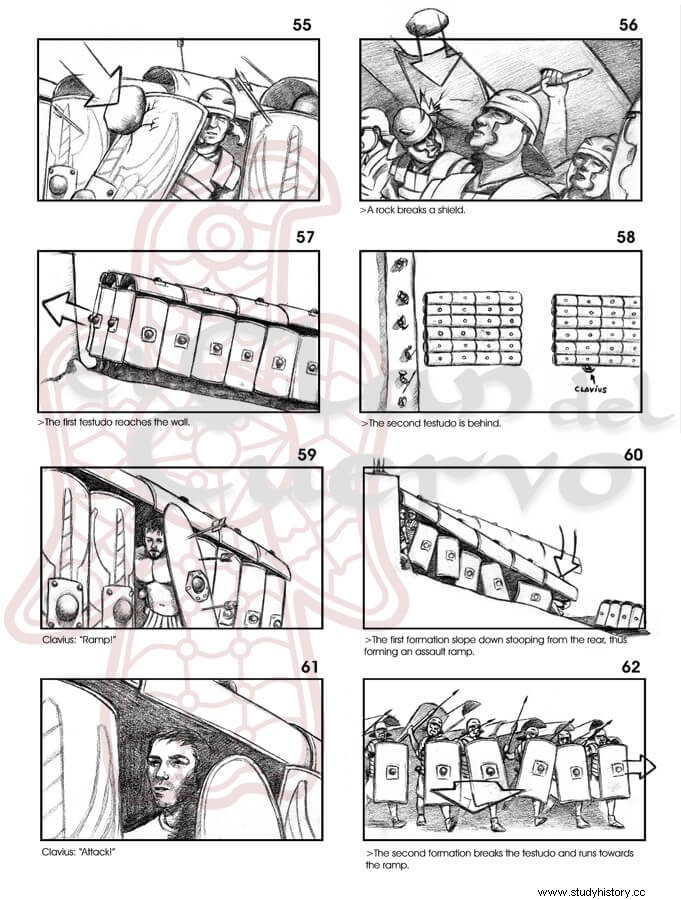
Joseph Fiennes , the film's protagonist, insisted that his Roman fencing instructor be present at rehearsals. It was about Dario Battaglia, founder of the gladiatorial group Ars Dimicandi, who had already worked as an advisor on Roman tactics for the series Roma from HBO. His personal chemistry instantly surfaced, and far from being an interference, his study of the workings of the maniples was an invaluable help. The instruction team was made up of actor Jon Bermúdez, a former member of the Special Operations Groups (GOE), Joaquín de Diego, historical advisor to several recreation parties, as well as Miguel Díaz de Espada and Eduardo Calle, colleagues from El Clan of the Raven. Some soldiers of the "Rey Alfonso XIII" Brigade II of the Legion who were on leave showed up for the casting and collaborated spontaneously. Our "authentic legionnaires" integrated perfectly into the improvised hierarchical ladder.
The first stumbling block arose from the low rigor of replica weapons and wardrobe. Aside from the fancy helmets and leather segmentatas, the prop company's shields, inspired by the reliefs of Trajan's Column, whose size is scaled to highlight the human figures, were too small to form in testudo . Some scuta had to be made on the fly fiberglass, with the approximate dimensions of a Dura Europos find (1.02 x 0.83 m). In the film it is possible to see both models.
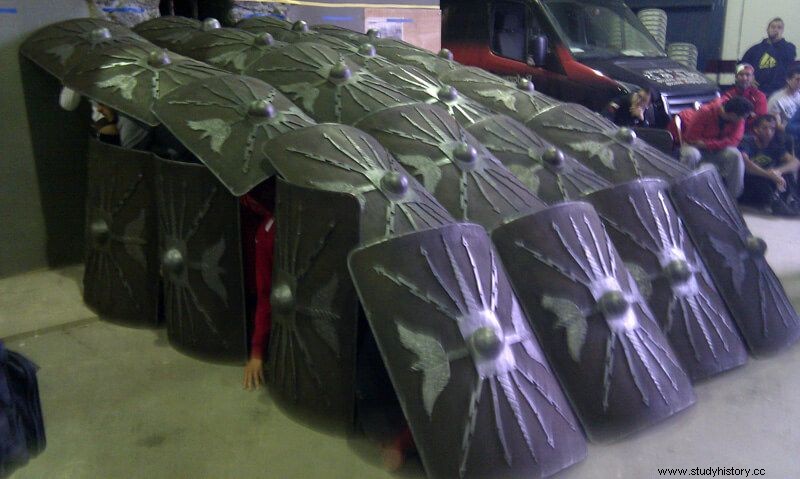
The usefulness of the testudo is such that, at present, the anti-riot units they still use it as a defensive resource. Suffice it to recall the overlapping shield formations in the March 2014 riots in kyiv's Independence Square. The functionality of the Roman "tortoise", in short, is beyond doubt and there are images of demonstrators climbing over the police, as in the protests in Caracas in February of that same year. However, the possibility that a ramp formed by shields would provide a platform stable enough for a large number of legionnaires in full panoply to climb up it was an unknown (at least for me).


Despite developing in a context in which the artistic prevailed at all times over research, the practices allowed us to carry out a work of experimental archeology during five days of rehearsals and six days of filming with a relatively large number of participants. Circumstance that is not usually common, not even in the field of historical reenactment. Thanks to this we were able to reach a series of conclusions.
The first row of shields must be well seated on the wall, since the rest of the rows rest on it. The legionnaires in the last row must kneel to place the shield behind their backs, or sit on the ground with their backs to their companions, avoiding the formation of a "step" that is too high for those who use the ramp. Since the scuta they overlap in rows like tiles, the weight of the assailants is distributed fairly evenly among the members of the formation. However, it is convenient that, in addition to the left hand, the shield has another point of support, which can be the right hand, the head protected by the helmet, or both. Another problem was that the studs on the soles of the caligae they made that platform slippery, especially on that last row of shields which, by force, presents a greater slope. Although the replicas were made of fiberglass, it must have been the case with the scuta as well. Romans. The best solution was to step on the umbones. Once these difficulties were overcome, the ramp was fully functional.
The scutum roman rectangular or "semi-cylindrical" it had a curvature that resembled a tile. The legionnaires fought with the inner face close to the body, as shown in reliefs such as those in the Tropaeum Traiani from Adamclisi (Romania) and countless images of gladiators of the murmillo or secutor type . In this way, the shield “wrapped” the fighter and protected his left flank. This design could have added utility. The sliding or turning of the shields, in the chaos of such a compact formation, is common when the testudo it is running and can cause the roof to lose cohesion or have holes. The tile shape of the scutum Roman contributes to the fact that the shields fit one on top of the other, avoiding lateral slipping; the umbones also serve as a stop so that they do not move longitudinally. Although the experience of the Clan del Cuervo with early medieval shields shows that it is possible to create a rudimentary testudo , its circular shape makes it difficult for there to be no gaps and, being flat, a uniform arrangement seems like a chimera.
There is no doubt that the testudo ramp It makes no sense before walls of entity. The possibility of creating several levels of scuta superimposed, as some imaginative engravings show, seems altogether unlikely. However, this maneuver can be an effective resource to break through a palisade or a wall of 2-3 meters. The Roman campaign camps, called castra aestiva, they were defended by a V-shaped ditch, an embankment or agger, and a palisade of intertwined branches (lorica ) or portable stakes known as pila muralia . The treatise De munitionibus castrorum of Pseudo-Hyginio advises that the agger have a height of at least six Roman feet and the pit a depth of three. This sloping drop of nine feet, that is, about 2.7 meters, could be overcome thanks to a testudo ramp. . It seems feasible that, as Tacitus relates, the Germans learned to make this ramp as a complementary measure to the scales. The defenses of the Roman winter camps, with dimensions similar to those of the indigenous forts, could also be breached with a testudo ramp. if the ditch was filled in or earth was piled up at the foot of the wall. The castra hibernates of Renieblas III, about 8 kilometers from Numancia, had a wall 5 meters wide and about 3 meters high.
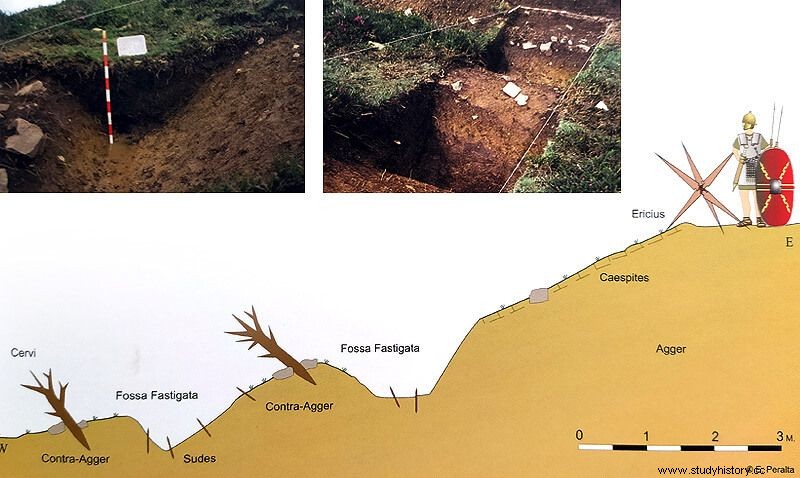
In the historical war genre, the usual is that a battle with white weapons is conceived as the sum of countless individual combats. Shortly before the clash between formations, the soldiers usually charge in disorder, creating a chaos in which there is not even a "battle axis". There are no lines, no relays between them, and a legionnaire can fight with his back to an enemy involved in another "duel". Our objective for this production was to show the usefulness of formations and to present Roman tactics as the decisive factor that allowed the legions to win many times with ostentatious inferiority in numbers. The final result, detracted in part by the costumes, we believe speaks for itself.

